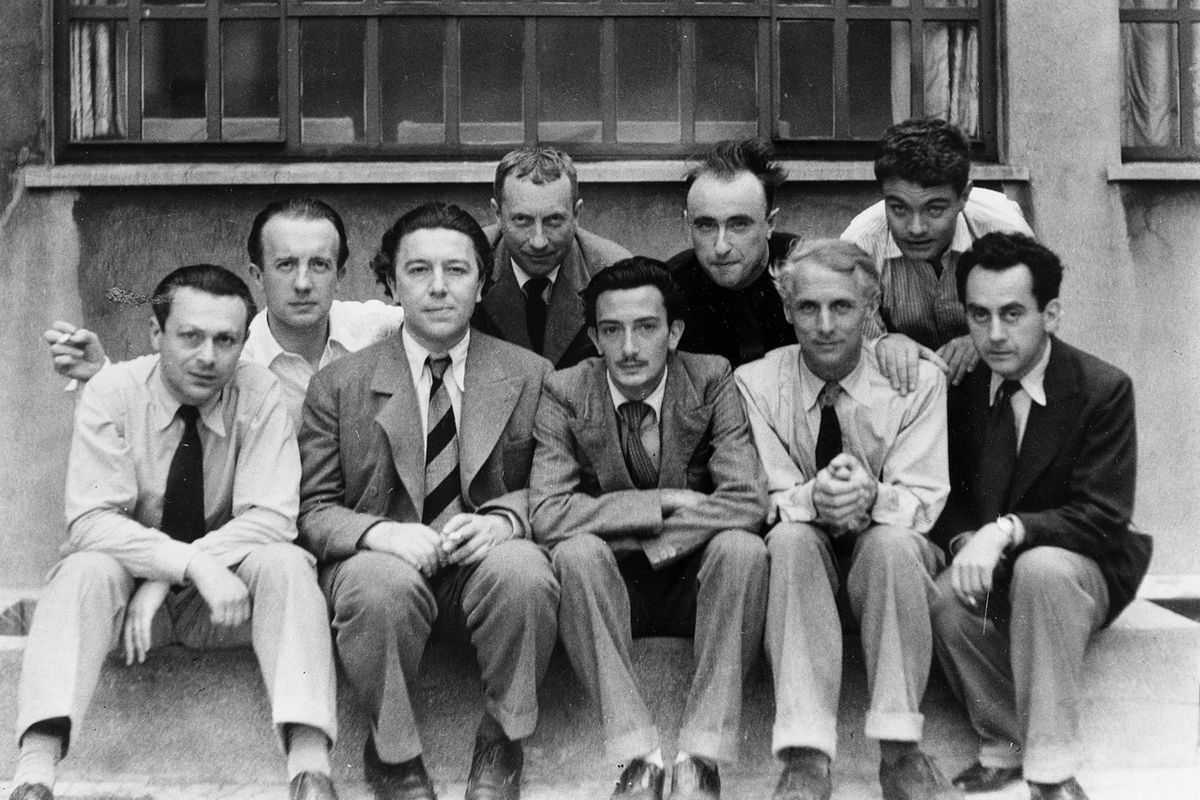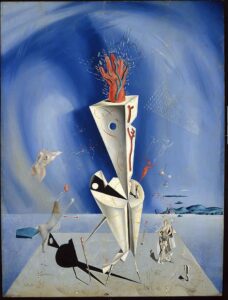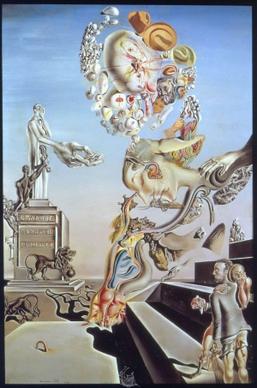Surrealism and the creativity that sparks from the subconscious
Started from the ashes of the first world war, the surrealistic movement had in Paris its main cultural center where the artists exchanged thoughts and influences and developed the idea and philosophy.

Giving more importance to dreams than to reality, to irrationality and subconscious more than to rationality and logical, the artists and writers refused the cult of reason inherited from the illuminism and followed a new path, under the guidance of André Breton, leader and founder of the movement.
In his first “Manifest of Surrealism”, written in 1924, Breton defined Surrealism as the search for a new reality, the surreality, where the real and the oniric lives cross and mix, giving birth the a new creativity, the creativity of subconscious.
Sigmund Freud and his theory of psychoanalysis, according to which human thoughts and feelings are influenced by the psychical processes of the unconscious layer, become the pillars for this new creativity.
Psychoanalysis invites the patient to express their feelings, dreams and thoughts in a spontaneous free flow, without the use and limits of rationality. This symbolical interpretation of dreams and of unrestricted associations, become the guiding path for the artists to free their creativity.
In his manifestoes Breton defined surrealism as: “Psychic automatism in its pure state, by which one proposes to express-verbally, by means of the written word, or in any other manner-the actual functioning of thought. Dictated by thought, in the absence of any control exercised by reason, exempt from any aesthetic or moral concern”. At the core of this idea there is the research and experimentation aimed at the liberation from the control imposed by rationality toward a new reality, completely unbound to any rational thought.
Dream and reality, oneiric and real life, past and future cease to exist in their essence of opposed entities and are reinterpreted by the artist, becoming interwoven and coexisting through the work of art. Sleep and dream are the fundamental pillars for the activation of the automatic thinking and the creativity of the artists. Sleep is a key aspect for many surrealists. Amongst them Salvador Dali considers it as a core element for the realization of his art and methodically focuses on it, using sleep as a tool.
Salvador Dalí and his relation with the surrealist movement

Salvador Dalí at the time in which the first manifesto was published was still at the Royal Academy of Arts in Madrid and his style was still inspired by cubism. He got closer to the surrealism movement only later and quickly became one of its main interpreters. His first surrealist masterpieces are the 1927 “Honey is Sweeter than Blood” and “ Apparatus and Hand” paintings. In 1929 he was amongst the artist who signed the second Surrealist Manifesto redacted by Breton.
His relation with the movement however was never simple, his extravagance and irrationality were probably excessive even for the surrealist. In 1939 he was expelled from the official movement for his political view far from those of the movement that was turning toward anarchist and Marxist ideas to counter the growth of the far right in the European countries.
Years later he claimed: “I am surrealism, I am the only one who is carrying it on. I have repudiated nothing; on the contrary, I have reaffirmed, sublimated, hierarchized, rationalized, dematerialized, spiritualized everything”.

In 1929, the year when he painted “The Lugubrious Game” he developed the paranoiac critical method, in his words “a spontaneous method of irrational knowledge based on the interpretative-critical association of delirium phenomena”. During the summer Dali had a group of surrealists as guests in Cadaques, among them Magritte, Luis Bunuel and Paul Eluard with his wife Gala and their daughter. The painting triggered a vivid interest in the surrealists and lead to Dali´s acceptance in the movement. In that same summer Gala Eluard fell in Love with Dali and decided to remain with him, leaving Eluard.
Through his surrealist and oneiric vision, Dali uses art to shake our thoughts, free our unconscious, frighten our rationality. With art he wants to question us, invite us to find new meanings and communicate directly with our souls through his incredible imagination.
The role of dreams in Salvador Dalí art
For Dali deep sleep is absolutely necessary to complete with success the work of art. In his book “50 Secrets of Magic Craftsmanship” he writes: “A heavy, long and peaceful sleep will therefore be most propitious, not only to create the physical and psychic calm to be desired in order to attain the coolness necessary to face the white and menacing bull of your virgin canvas which, at the end of your faena, is to fall immortalized by the death stroke of your last touch, but also and expecially, you must know that it is precisely during this sleep, which you wrongly regard as reducing you to a state of paradoxical inactivity and indifference before the immence of the work which you are prepariong to execute, that you will secretly, in the very depths of your spirit, solve most of its subtle and complicated technical problems which in your state of waking consciousness you would never be humanly capable to solving”.
According to Dali after this deep sleep, at the awakening, most of the relevant work for the realization of the artwork has been accomplished. “When I awake, ballet dancers leap in my brain. As I retain the image I sketch them before they run away”.
The creative energy should be triggered with a specific methods that he calls “slumber with a key”. “You must seat yourself in a bony armchair, preferably of Spanish style, with your head tilted back and resting on the stretched leather back. Your two hands must hang beyond the arms of the chair, to which your own must be soldered in a supineness of complete relaxation. […] In this posture, you must hold a heavy key which you will keep suspended, delicately pressed between the extremities of the thumb and forefinger of your left hand. Under the key you will previously have placed a plate upside down on the floor…. The moment the key drops from your fingers, you may be sure that the noise of its fall on the upside down plate will awaken you.” This sudden awakening is extremely important as “Only the last dream, the one closest to waking, can be influenced and directed”.
The “Persistence of Memory” and the “Profile of Time”
If it wasn´t for sleep and meditation, possibly today we wouldn´t have the chance to admire many of Dali´s masterpieces, including the “Persistence of Memory”, considered by many as his most important painting and conceived right after a nap by a piece of melting camembert.

Dali himself in his autobiography “The secret life of Salvador Dali” describes: “It was on an evening when I felt tired, and had a slight head-ache, […]. We were to go to a moving picture with some friends, and at the last moment I decided not to go. Gala would go with them, and I would stay home and go to bed early. We had topped off our meal with a very strong Camembert, and after everyone had gone I remained for a long time seated at the table meditating on the philosophic problems of the «super-soft» which the cheese presented to my mind. I got up and went into my studio, where I lit the light in order to cast a final glance, as is my habit, at the picture I was in the midst of painting. This picture represented a landscape near Port Lligat, whose rocks were lighted by a trasparent and melancholy twilight, in the foreground an olive tree with its branches cut, and without leaves. […] I was about to turn out the light, when instantaneously I «saw» the solution. I saw two soft watches, one of them hanging lamentably on the branch of the olive tree. In spite of the fact that my head-ache had increased to the point of becoming very painful, I avidly prepared my palette and set to work. When Gala returned from the theatre two hours later the picture, which was to be one of my most famous, was completed”.
The sculpture “Profile of Time”, conceived in 1977 and recalling the soft watch leaning on the tree in “the persistence of memory”, perfectly illustrates the concept of sleeping without sleeping, of that interim between unconsciousness and consciousness. Like in the painting the watch is softly lied on the branches of an olive tree, its shape melting toward a droplet that doesn´t reach the ground but seems portrayed in the instant just before its fall. The droplet mimics the spoon about to fall on the plate and thus the moment just before the awakening of the dreamer.
With the “profile of time” Dali shows time as it appears in dreams, in the instant just preceding the awakening which inevitably would bring us back to reality and rationality.

Hello guys! Good article Home –
Admin – Nice Article! Home
Hello guys! Nice article Home –
Thanks, +
interesting news
I am sure this post has touched all the internet users, its really really pleasant
post on building up new blog.